Digital Branding Strategies
10 Brand Guidelines Examples to Inspire and Elevate Your Branding
Overview
Brand guidelines are not merely suggestions; they are essential for creating a cohesive and recognizable identity that significantly enhances brand perception and fosters consumer loyalty. Effective guidelines encompass various components, including:
- logo usage
- color palettes
- tone of voice
Leading brands like Nike and Coca-Cola exemplify how consistent branding nurtures trust and emotional connections with consumers. By adhering to these principles, Brand Managers can ensure their brands resonate powerfully in a competitive marketplace.
Introduction
In today’s competitive landscape, where brand identity can decisively influence business outcomes, grasping and applying effective brand guidelines is paramount. These guidelines act as the definitive blueprint for a brand’s visual and verbal representation, covering essential elements from logo usage to tone of voice.
As organizations endeavor to cultivate a cohesive and recognizable presence, the critical nature of consistency becomes apparent; it not only engenders consumer trust but also nurtures brand loyalty. Amidst shifting market dynamics, brands are compelled to refine their strategies while steadfastly upholding their core identity.
This article explores the fundamental components of brand guidelines, underscores the importance of consistency, and outlines best practices for crafting and executing these guidelines, ultimately enhancing brand perception and driving business success.
Understanding Brand Guidelines: The Foundation of Effective Branding
Brand guidelines examples are essential for establishing a cohesive framework that dictates how an identity is visually and verbally represented. These guidelines encompass critical components such as logo usage, color palettes, typography, and tone of voice. By adhering to these specifications, businesses can cultivate a consistent identity that resonates profoundly with their target audience.
Consider the case of WonderEight, a dynamic agency that exemplifies the power of a strong collection of identity standards. By ensuring that all marketing materials reflect its innovative and creative ethos, WonderEight boosts recognition and fosters customer loyalty.
The importance of identity guidelines is underscored by recent statistics revealing that 72% of leading brands utilize invented words or acronyms in their titles, highlighting the creative potential inherent in marketing. Furthermore, a compelling identity can significantly sway consumer behavior; a study indicates that 59% of consumers prefer to wait for products from their favored brand rather than seek alternatives, emphasizing the power of loyalty. This aligns with the understanding that robust branding can yield substantial benefits, such as reducing new hire costs by 50% through effective employer branding strategies.
As we look to 2025, trends in corporate standards are evolving to incorporate more flexible and adaptive strategies, enabling businesses to remain relevant in an ever-changing market. This adaptability is crucial, as value increasingly reflects a company’s worth, market position, and customer loyalty—key drivers of revenue and competitive advantage.
Effective identity standards typically comprise brand guidelines examples that offer a comprehensive overview of visual components, messaging structures, and usage regulations to ensure consistency across all platforms. Experts in identity management assert that well-structured protocols not only enhance identity recognition but also streamline marketing initiatives, empowering teams to produce cohesive content.
Integrating insights from branding specialists reveals that robust identity standards are vital for companies seeking success in today’s competitive landscape. They lay the groundwork for establishing a reputable image, as encapsulated by Ben Franklin’s wisdom: “It takes many good deeds to build a reputation, and only one bad one to lose it.” This underscores the necessity of maintaining a uniform and favorable company image through efficient protocols.
Case studies serve as brand guidelines examples that illustrate the impact of implementing effective identity standards. Organizations that have adopted comprehensive identity principles often witness enhanced recognition and loyalty, reinforcing the notion that a strategic approach to marketing is essential for sustained success. For instance, WonderEight has successfully introduced identity standards for various clients, resulting in improved visibility and customer engagement across diverse sectors.
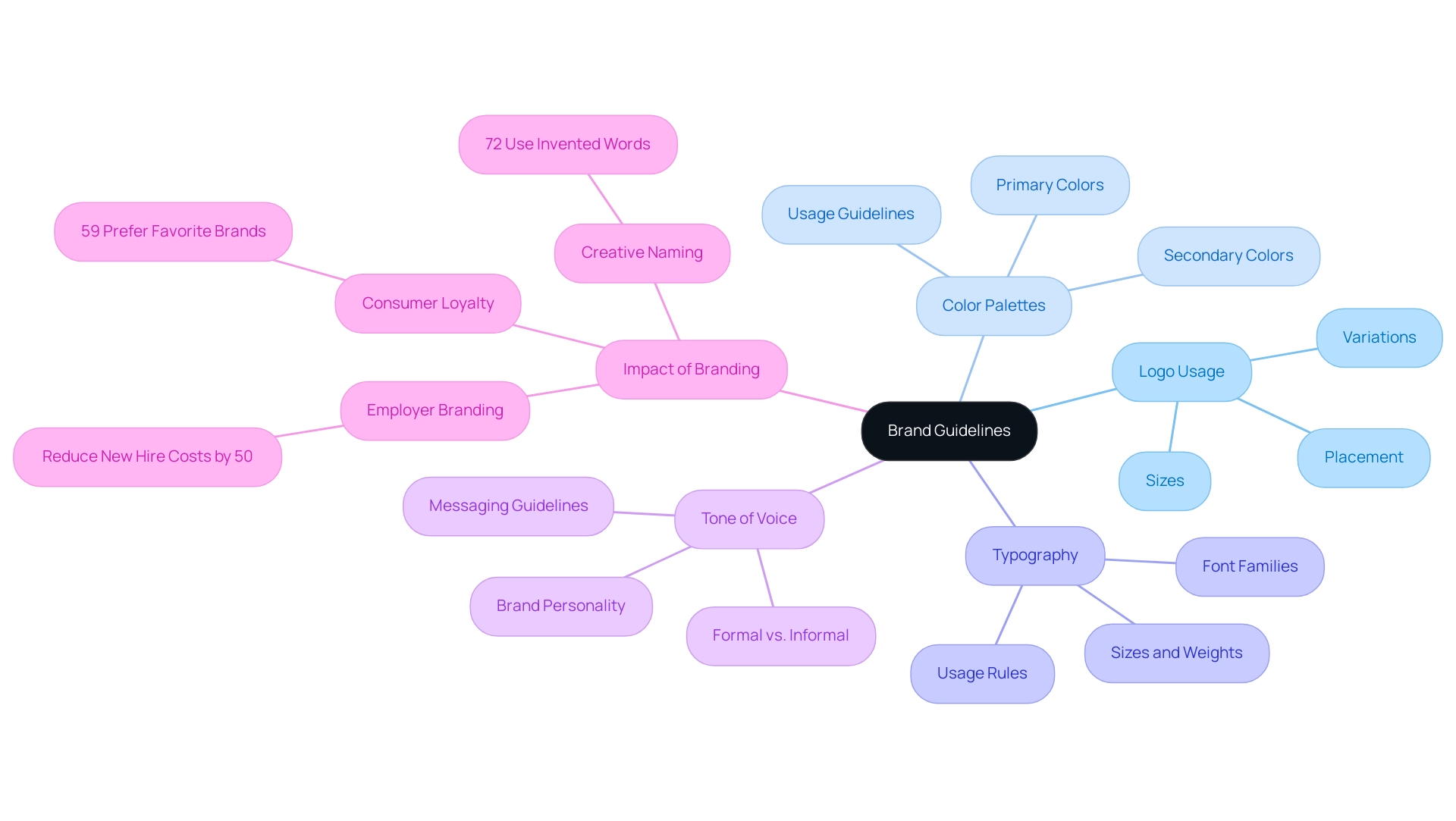
The Importance of Consistency in Brand Guidelines
Consistency in guidelines is paramount for ensuring uniform communications, a factor that significantly contributes to building consumer trust. When companies utilize varying logos or color schemes across different platforms, confusion among customers can arise, ultimately diluting brand identity. Quaker Oats serves as a prime example of successful consistency, having maintained a cohesive image that has bolstered its strong market presence.
Studies indicate that 45% of consumers prioritize exceptional design across sales and marketing materials, highlighting the critical link between design consistency and consumer trust.
The impact of a consistent identity on consumer trust is profound. Research indicates that companies with a consistent identity are perceived as more trustworthy, which is essential in today’s competitive environment. Notably, companies that maintain consistency in their marketing efforts not only enhance recognition but also foster loyalty among their audience.
This is evident in the case of Quaker Oats, which has effectively leveraged its guidelines to create a recognizable and trusted image. This showcases how WonderEight’s strategic approach to marketing can lead to similar successes for clients.
Expert insights reveal that uniform identity is not merely a design choice but a strategic imperative. Brand managers emphasize the importance of consistency, noting that it plays a vital role in shaping consumer perceptions and building long-term relationships. For instance, Josh Howarth notes that only 29% of low-earners trust their labels compared to 38% of high-income shoppers, illustrating how consistency can influence trust across different demographics.
By following brand guideline examples, businesses can cultivate a cohesive image that resonates with their audience, ultimately driving trust and loyalty. The varying costs associated with achieving consistency in identity are underscored by examples such as Pepsi’s $1 million logo design expenditure, reinforcing the strategic importance of investing in identity efforts. Furthermore, the role of logo design is critical; symmetrical logos are often perceived as more reliable, further supporting the necessity of uniform branding.
Essential Components of Effective Brand Guidelines
The use of brand guidelines examples is crucial for maintaining a cohesive and recognizable identity. They encompass several key components:
-
Logo Usage: This section provides clear instructions on how to use the logo, detailing variations, spacing, and placement to ensure consistent application across all platforms. Pepsi’s investment of $1 million in logo design underscores the significance of a well-defined logo strategy. WonderEight excels in creating customized logo designs that not only meet client specifications but also resonate with target audiences, ensuring impactful representation.
-
Color Palette: A defined set of colors that symbolize the identity is essential. This comprises primary and secondary colors, which enhance recognition and evoke specific emotions and associations in the audience. Research indicates that 3% of consumers follow no labels, highlighting the need for distinct and memorable color schemes to capture attention. WonderEight addresses this challenge by developing unique color palettes that help clients stand out in a crowded marketplace.
-
Typography: Specifications for font styles, sizes, and usage are vital for maintaining visual consistency. Typography should reflect the identity’s personality and be legible across various mediums. WonderEight’s expertise in typography ensures that each label’s voice is communicated effectively through its visual elements.
-
Imagery: Guidelines on the types of images that align with the identity of the organization help in creating a unified visual language. This includes recommendations for photography styles, illustrations, and graphics that resonate with the target audience. WonderEight’s approach to imagery focuses on creating visuals that enhance storytelling and engagement.
-
Tone of Voice: Instructions on how the organization communicates with its audience are essential for establishing a relatable and authentic presence. This includes guidelines on language, style, and messaging that reflect the organization’s values and mission. WonderEight highlights the significance of a consistent tone of voice in all client communications, ensuring alignment with identity.
Incorporating brand guidelines examples allows companies to ensure that their messaging is consistent and aligned with their identity. As marketing specialist Michelle Noel observes, “Adhering to protocols enables strategists to make knowledgeable and intentional choices regarding how to communicate their narrative.” This principle is at the core of WonderEight’s marketing strategies, designed to empower clients to tell their unique stories effectively.
Furthermore, case studies like the digital campaign for Motorola demonstrate the effectiveness of clearly defined identity standards. WonderEight’s innovative strategies, including targeted digital marketing and audience engagement techniques, significantly enhanced Motorola’s online presence and interaction, demonstrating the tangible benefits of adhering to comprehensive branding principles. By concentrating on these crucial elements, companies can develop impactful policies that not only enhance their identity but also foster engagement and loyalty.
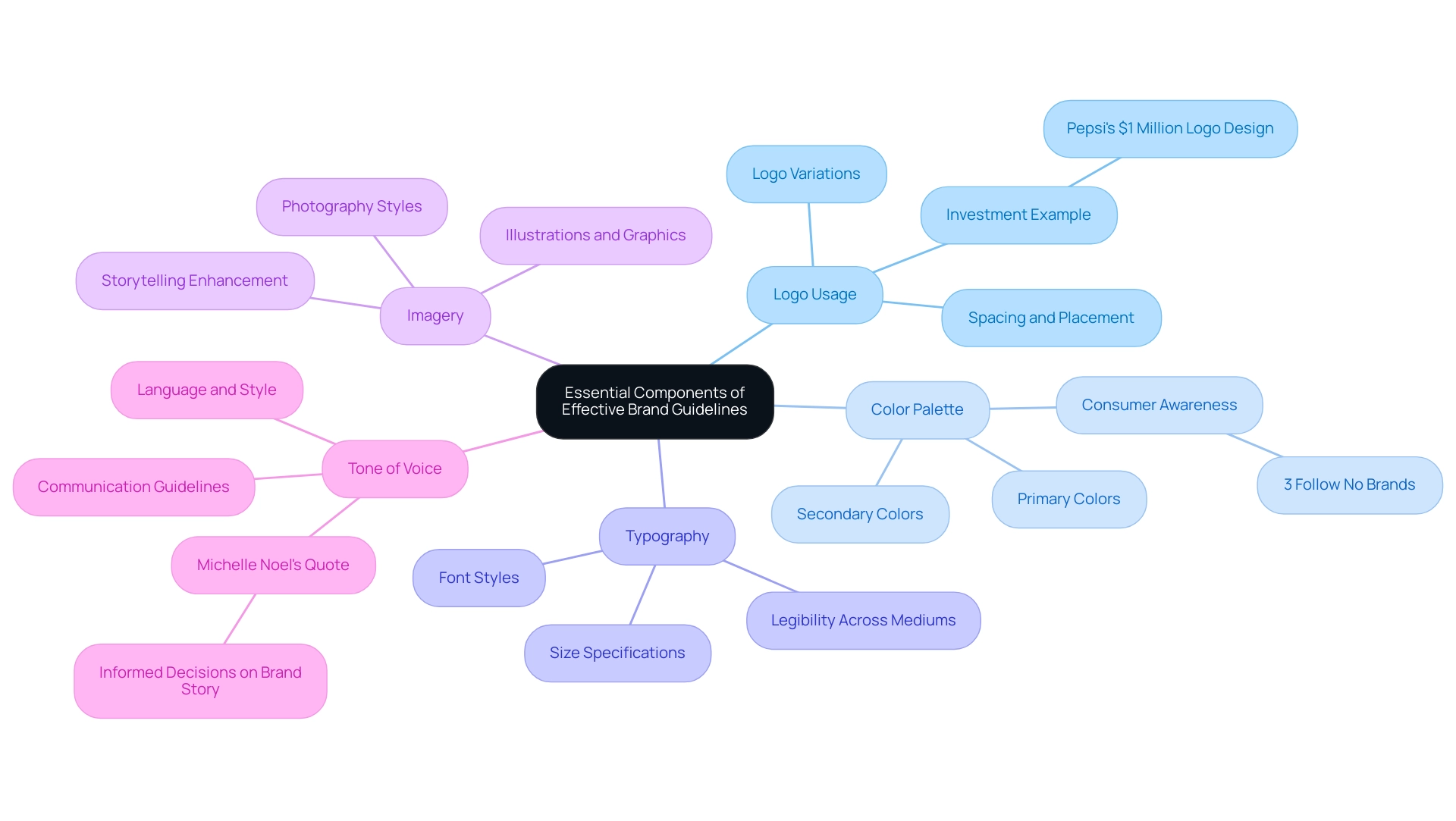
10 Inspiring Brand Guidelines Examples from Leading Brands
- Nike stands as a paragon of athleticism and innovation, renowned for its iconic swoosh logo and bold typography. The brand’s guidelines ensure consistency across all platforms, reinforcing its commitment to performance and excellence. This strategic approach has solidified Nike’s status as a leader in the sportswear industry, fostering unmatched loyalty. Notably, 72% of leading brands employ invented terms or acronyms, a strategy that Nike exemplifies through its distinctive identity. WonderEight can assist companies like Nike in refining their identity and enhancing market presence through customized identity solutions.
- Coca-Cola’s guidelines emphasize its classic red color and distinctive script font, pivotal in ensuring global recognition. This consistency has enabled Coca-Cola to maintain a strong emotional connection with consumers, leading to a remarkable 96% increase in conversion rates through effective storytelling. Insights from the case study titled “The Power of Storytelling” illustrate how emotional connections foster stronger loyalty. WonderEight’s expertise in storytelling can aid companies in crafting narratives that resonate profoundly with their audience.
- Apple’s minimalist design philosophy is evident in its principles, prioritizing simplicity and elegance. This approach not only enhances user experience but also reinforces identity, making Apple synonymous with innovation and quality. Their brand guidelines serve as a benchmark for tech companies aspiring to achieve a sleek and modern aesthetic. As marketing tech expert Krunal Vaghasiya notes, effective branding strategies can significantly boost e-commerce conversion rates. WonderEight provides comparable design principles to assist tech companies in attaining a modern aesthetic.
- Airbnb’s guidelines highlight inclusivity and community, utilizing vibrant imagery and friendly language to create a welcoming atmosphere. This strategy has cultivated a strong emotional connection with users, enhancing loyalty and encouraging repeat usage. WonderEight can leverage these principles to assist clients in creating inclusive identities that resonate with diverse audiences.
- Spotify’s principles showcase a dynamic color palette and playful typography, reflecting its youthful character. By aligning their visual identity with their target audience’s preferences, Spotify has successfully positioned itself as a leader in the music streaming industry. WonderEight can help companies create vibrant identities that attract their target demographics.
- Starbucks emphasizes its green color and coffee culture in its guidelines, creating a warm and inviting image. This consistency not only enhances customer experience but also reinforces the brand’s commitment to quality and community engagement, illustrated through brand guidelines examples. WonderEight’s branding strategies can help similar businesses cultivate a strong community presence.
- Google’s guidelines focus on simplicity and functionality, providing clear instructions for logo usage and color combinations. This clarity ensures that the company remains accessible and user-friendly, crucial for maintaining its position as a leader in technology. WonderEight can assist tech firms in achieving similar clarity in their marketing efforts.
- Target’s guidelines highlight its signature red color and bullseye logo, reinforcing its identity as a fun and accessible retailer. This strategic branding has helped Target cultivate a loyal customer base, fostering a strong emotional connection that drives repeat business. WonderEight can assist companies in developing memorable identities that foster customer loyalty.
- FedEx’s guidelines emphasize reliability and speed, utilizing bold typography and a clear color scheme. This focus on clarity and efficiency resonates with customers, enhancing their trust in the brand’s delivery services, supported by brand guidelines examples. WonderEight’s identity solutions can assist logistics companies in conveying their reliability effectively.
- Dropbox’s guidelines prioritize clarity and simplicity, employing a clean design that reflects its user-friendly approach. This commitment to clear marketing has contributed to Dropbox’s success in the competitive cloud storage market, making it a preferred choice for users seeking efficiency and ease of use. WonderEight can assist cloud service providers in developing clear and effective marketing strategies.
In conclusion, investing in identity is crucial for long-term ROI, as a strong identity creates lasting impressions, builds customer relationships, and enhances value. Client success stories, such as the identity uplift for Castania and the digital campaign for Motorola, further illustrate the effectiveness of these marketing strategies in achieving measurable outcomes, showcasing WonderEight’s impact across industries.
How Strong Brand Guidelines Enhance Brand Perception
Robust identity principles are essential in enhancing public perception by ensuring that all communications align with core values and the brand’s essence. When individuals encounter consistent messaging and visuals, they are more likely to cultivate a positive perception of the company. A prime example is Castania’s identity enhancement in 2025, which illustrates how clearly defined principles can lead to increased trust and loyalty among customers.
This transformation not only bolstered their market presence but also fostered a deeper emotional connection with their audience.
Research underscores that companies leveraging brand guidelines experience a significant boost in public perception. Notably, 72% of the most successful companies utilize unique names or acronyms, enhancing memorability and recognition. Furthermore, industry experts assert that coherent communication is vital; marketing specialists maintain that companies that uphold consistency across all platforms are more likely to cultivate trust among clients.
Josh Howarth highlights a striking disparity in trust levels, noting that only 29% of low-income earners trust their labels, compared to 38% of high-income shoppers. This disparity emphasizes the importance of perception across various demographics, particularly in the B2C sector, where purpose-driven companies are increasingly favored by consumers—many of whom are willing to make purchases based solely on brand names.
The impact of robust identity standards transcends mere recognition; they also fortify loyalty. Brands that effectively communicate their values and maintain a cohesive image are better positioned to forge lasting relationships with their customers. Case studies demonstrate that companies enhancing their image through brand guidelines focus on personalization and customer experience as critical components.
By leveraging user-generated content and nurturing emotional connections, companies can significantly improve their loyalty metrics.
What distinguishes WonderEight is its commitment to integrating creativity with technology, ensuring that projects are both visually captivating and strategically sound. For instance, WonderEight has successfully established identity standards for various clients, resulting in enhanced recognition and customer engagement. In conclusion, the application of strong identity standards not only elevates reputation but also reinforces consumer confidence, ultimately driving business success.
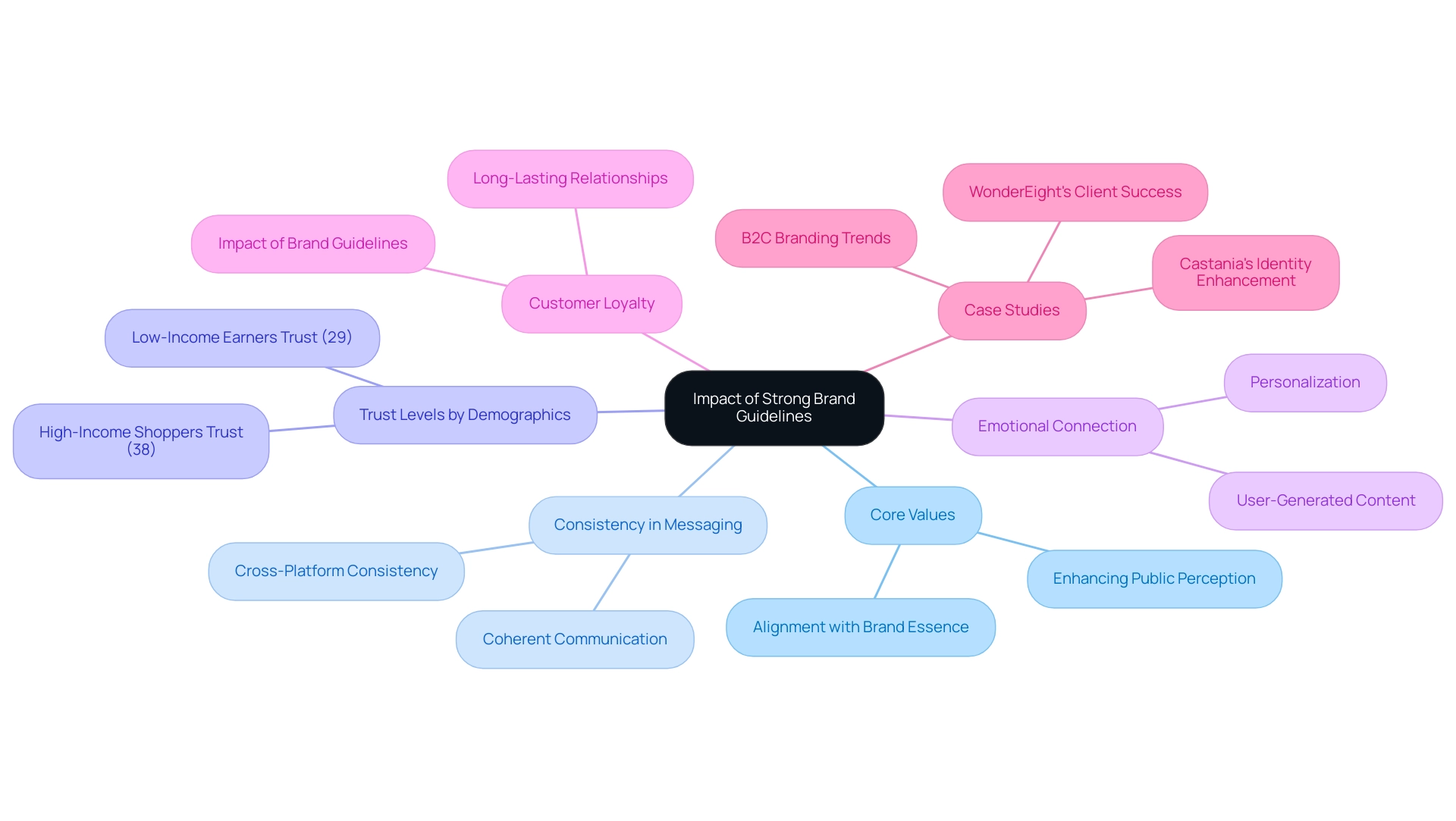
Aligning Teams: The Role of Brand Guidelines in Internal Communication
Brand guidelines examples are indispensable for aligning internal teams with a company’s vision and values, providing a foundational framework for representation. These guidelines clarify how the identity should be presented, ensuring that every employee comprehends their role in maintaining consistency. For instance, when launching a new marketing campaign, teams can refer to brand guidelines examples to guarantee that their messaging is in harmony with the overall company image.
This alignment not only cultivates a sense of ownership and accountability among team members but also fosters a cohesive experience.
In 2025, the importance of identity standards in internal communication has become increasingly evident. Organizations that effectively implement these guidelines report enhanced collaboration and communication among teams. Statistics reveal that 69% of employees feel motivated to work harder when they perceive their contributions are valued, underscoring the necessity for clear communication channels that reflect organizational values.
As Max Messmer, Chairman of Accountemps, aptly noted, “improving workplace communication is one of the most effective – and least costly – ways to combat the problem of a disengaged workforce.”
WonderEight’s comprehensive digital and technology solutions—including social media strategy, digital audits, website and app design and development, and e-commerce CRM strategies—are pivotal in reinforcing these identity standards. Case studies illustrate the impact of identity standards on team dynamics. For example, organizations that prioritize internal communication and adherence to company standards experience a 50% reduction in turnover rates, highlighting the critical connection between effective communication and employee retention.
Notable client success stories, such as the identity enhancement for Castania and the digital initiative for Motorola, further exemplify how robust standards can yield measurable outcomes and internal cohesion.
Moreover, tools like Oak Engage enhance internal communication and collaboration, offering a centralized hub for company news and updates. By fostering a culture of collaboration and clarity, companies can ensure their teams are not only aligned with the vision but also empowered to contribute meaningfully to its success through WonderEight’s integrated branding and marketing solutions.
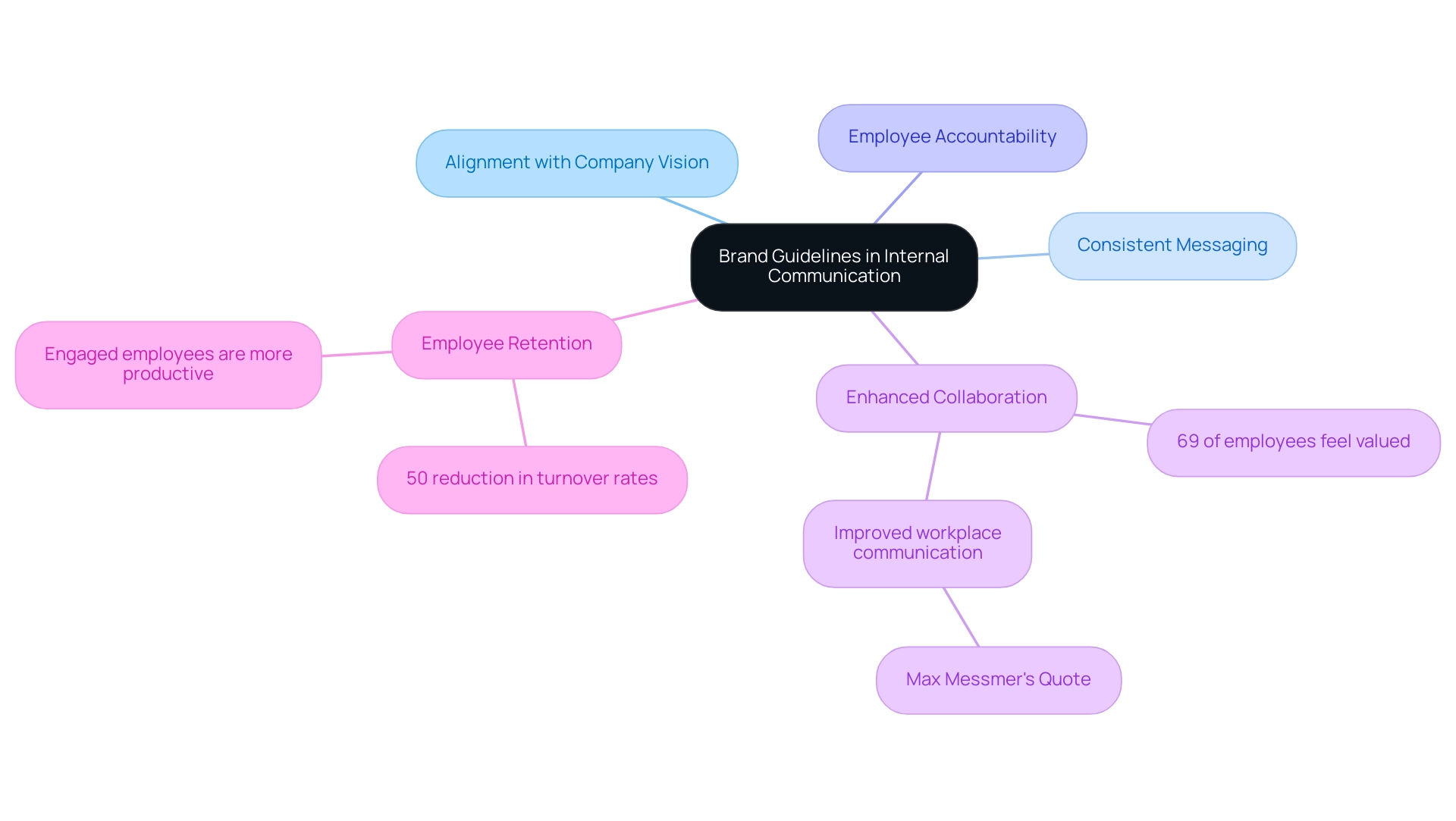
Creating Your Own Brand Guidelines: Best Practices and Strategies
Establishing effective guidelines is essential for maintaining a cohesive identity. Here are key best practices to consider:
-
Conduct Thorough Research: Understanding your target audience and current market trends is crucial. Research reveals that 82% of potential candidates consider a company’s reputation before applying for a job, highlighting the importance of a strong image. As marketing writer Audrey Rawnie states, “Your website is your identity’s primary representation in the online world.” It’s likely the first stop potential customers will visit when researching your business, which is why it’s essential that it leaves the right impression.
-
Define Your Brand Identity: Clearly articulate your brand’s mission, values, and personality. This foundational step ensures that all branding efforts align with your core identity.
-
Be Comprehensive: Your instructions should encompass all essential components, including logo usage, color palette, typography, and tone of voice. A well-rounded approach ensures consistency across all platforms.
-
Ensure Accessibility: Make your instructions easily accessible to all team members and stakeholders. This fosters a unified understanding of the company and encourages adherence to the established standards.
-
Regularly Update: Periodically assess and refresh your principles to reflect any changes in your identity or shifts in market dynamics. Staying current is vital in a rapidly evolving landscape.
By adhering to these practices, businesses can develop robust brand guidelines that not only support their marketing efforts but also resonate with their audience. Successful examples, such as WonderEight’s comprehensive identity solutions for clients like Castania and Motorola, showcase brand guidelines that demonstrate the effectiveness of tailored strategies blending creativity with technology. Additionally, statistics show that 73% of consumers enjoy nostalgia branding, underscoring the value of connecting with audiences on an emotional level.
Applying these insights will enable companies to develop standards that genuinely enhance their identity. WonderEight’s offerings, including audits and strategy formulation, further illustrate how companies can utilize expert advice in creating effective identity standards.
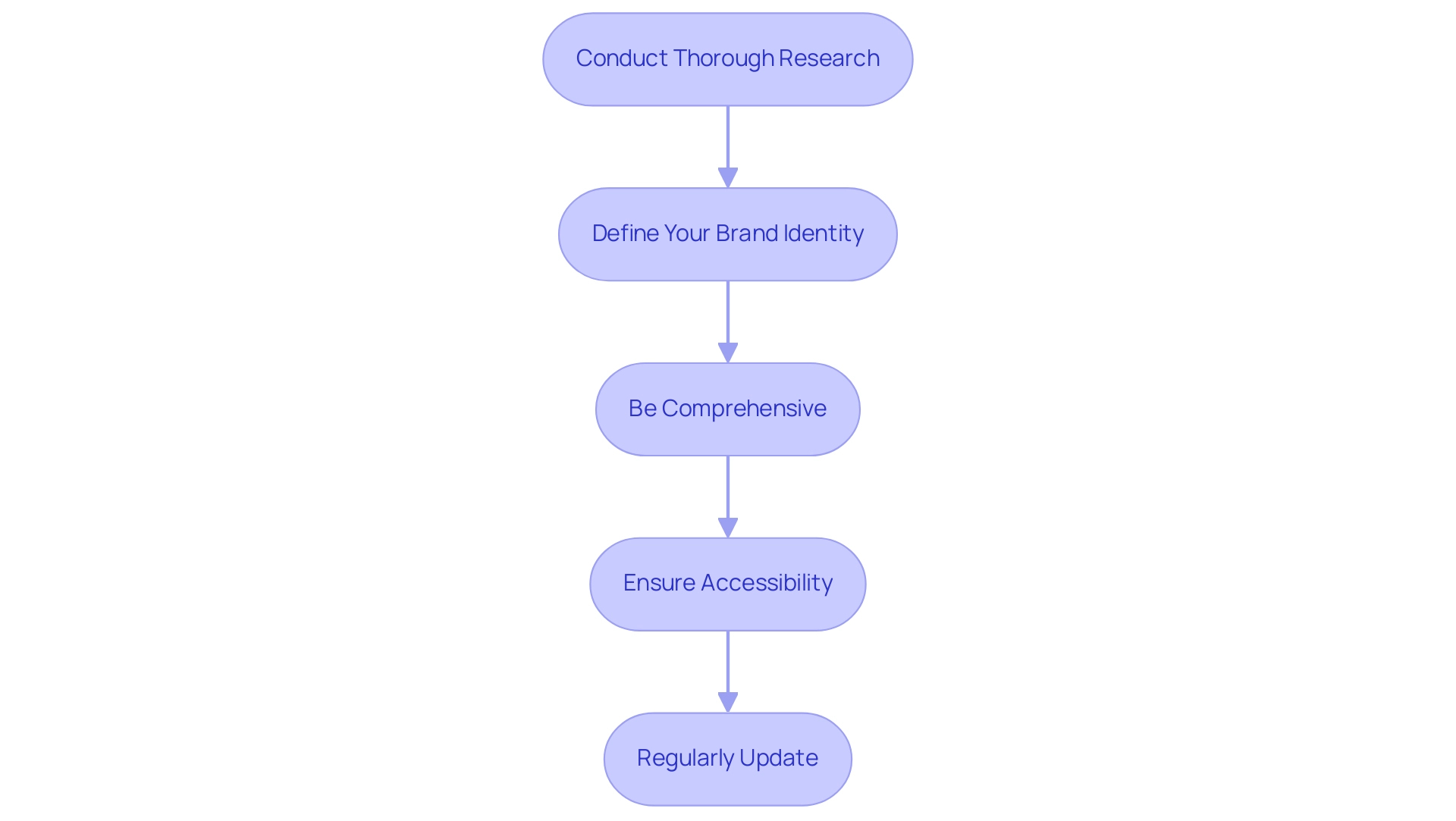
Overcoming Challenges in Brand Guidelines Implementation
Implementing brand guidelines examples can present several challenges that organizations must navigate effectively to ensure a cohesive brand identity. Key challenges include:
-
Employees often exhibit resistance when confronted with new protocols. To mitigate this, it is crucial to involve team members in the development process, fostering a sense of ownership. Providing comprehensive training can also facilitate smoother transitions and encourage buy-in. As Monique Solomons notes, improving your branding involves understanding your target audience and clearly defining your unique selling proposition.
-
Lack of Clarity: Ambiguity in identity standards can lead to inconsistent application. To combat this, ensure that instructions are articulated clearly and are easily digestible. Utilizing visuals and brand guidelines examples can significantly enhance understanding and retention of key concepts.
-
Inconsistency: Maintaining adherence to guidelines is essential for a unified presence. Routine monitoring and constructive feedback are essential in strengthening compliance across teams, aiding in pinpointing areas for enhancement and ensuring that the message remains consistent. Research indicates that 82% of customers purchase from a company when they have a strong emotional connection, underscoring the significance of a unified identity.
-
Limited Resources: Effective execution of branding standards necessitates sufficient resources. Organizations should allocate sufficient time and budget for training and ongoing support, which are essential for integrating these principles into the company culture. Moreover, a study disclosed that 62% of Gen Z individuals favor labels that emphasize sustainability and diversity, underscoring the necessity for companies to align their principles with modern values.
Tackling these challenges proactively can greatly improve the effectiveness of company guidelines. Trust in a company is important as it directly impacts purchasing behavior, with 81% of consumers stating it influences their decisions and 46% willing to pay more for a reliable name. By understanding these challenges and employing strategic solutions, businesses can cultivate a strong identity that resonates with their audience and drives loyalty.
Additionally, it is noteworthy that 72% of leading companies are named with made-up words or acronyms, illustrating innovative marketing strategies that can align with the challenges discussed.
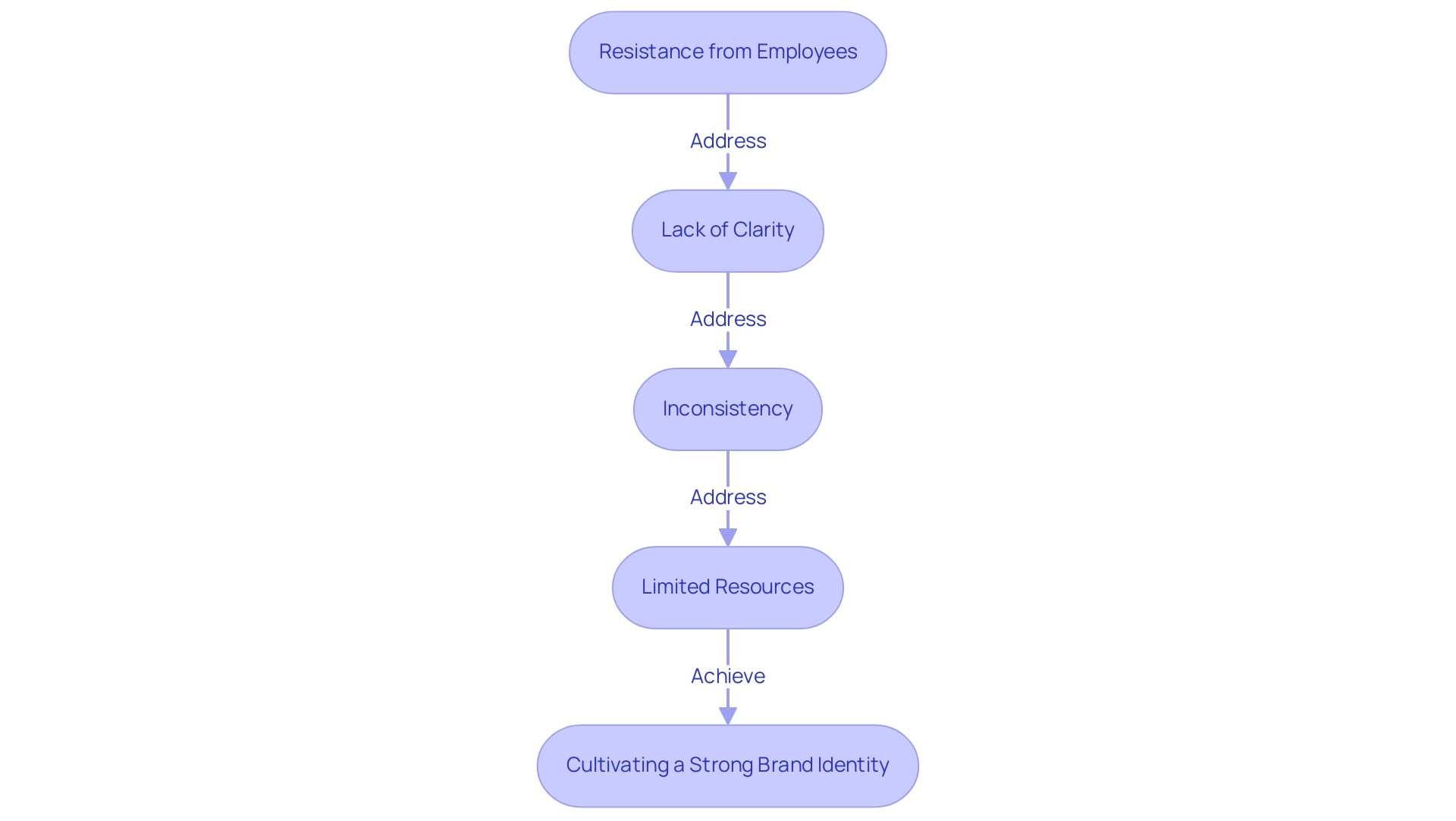
Adapting Brand Guidelines to Changing Market Dynamics
To effectively adapt guidelines to the ever-evolving market dynamics, businesses must implement the following strategies:
- Stay Informed: Continuously monitor market trends and buyer preferences. This vigilance is crucial for identifying emerging areas for adaptation, ensuring that the entity remains aligned with its audience’s expectations.
- Solicit Feedback: Actively gather input from customers and stakeholders. Understanding their views and anticipations is essential, as research indicates that only 29% of low-income individuals have confidence in their labels compared to 38% of high-income shoppers. This feedback can guide necessary adjustments to marketing strategies, underscoring the importance of consumer insights in shaping identity.
- Be Flexible: Incorporate flexibility within your guidelines. This adaptability allows for the integration of new trends while maintaining core elements. Marketing experts emphasize that a rigid approach can obstruct an entity’s ability to connect with its audience. As noted by Vistaprint, 60% of consumers avoid companies with unusual or unattractive logo designs, even if they have good reviews, highlighting the need for businesses to remain visually appealing and relevant.
- Test and Iterate: Implement changes on a trial basis and solicit feedback to refine your instructions. This iterative process not only enhances relevance but also fosters a culture of responsiveness to market shifts.
By proactively engaging with these strategies, businesses can ensure their identity remains relevant and engaging in 2025 and beyond. Significant instances include brand guidelines examples that highlight successful revisions to corporate standards by organizations embracing flexibility, showcasing the effectiveness of adjusting to market changes. For example, WonderEight’s extensive campaigns for companies like Miranda and Quaker Oats demonstrate how engaging content and strategic marketing can enhance experiences and trust, showcasing their distinctive ability to merge creativity with technology.
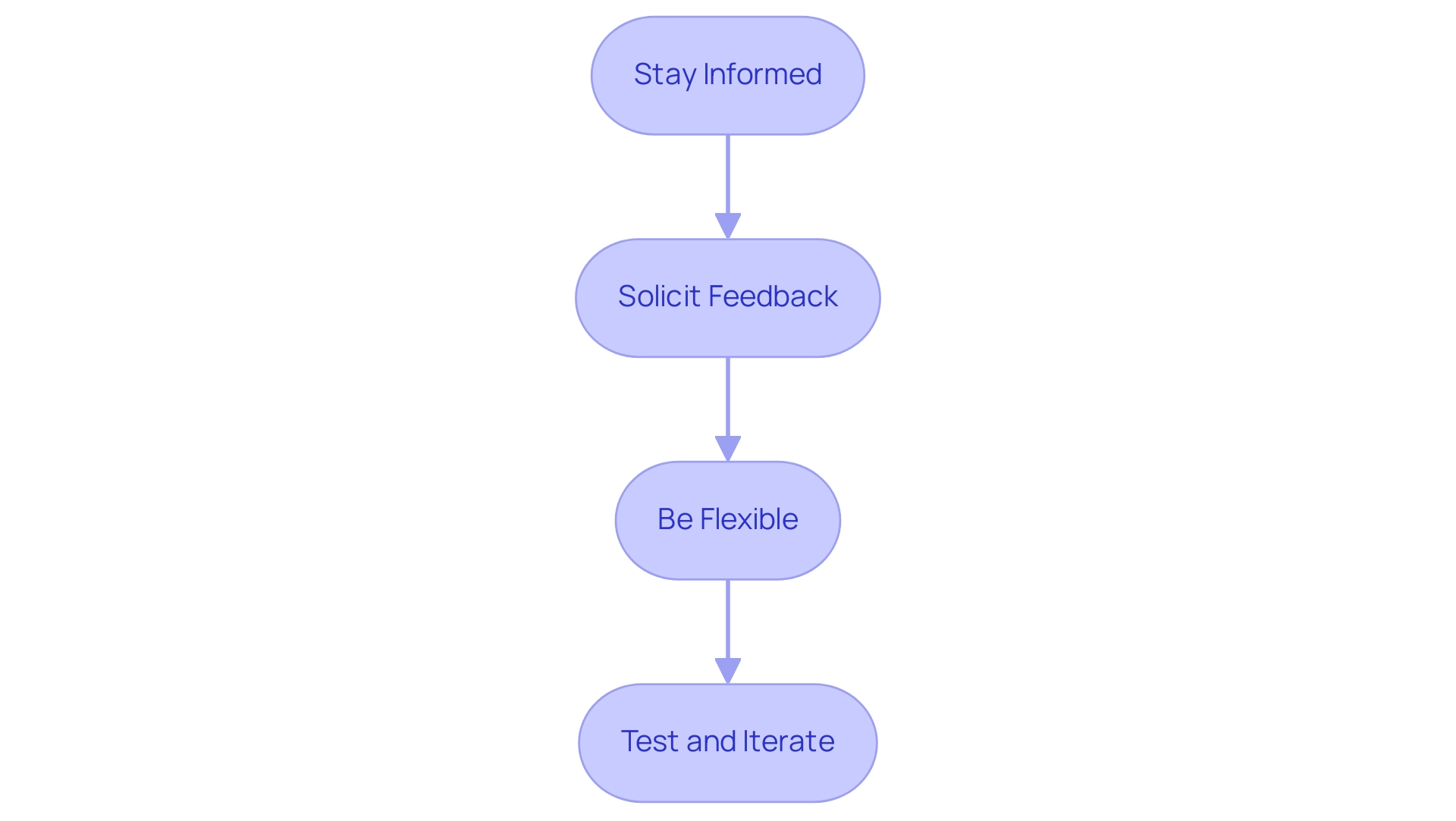
Leveraging Brand Guidelines for Successful Branding Strategies
Utilizing identity standards efficiently can significantly enhance marketing strategies. Here are some critical insights:
- Consistency is Essential: Adhering to established standards is crucial for building trust and recognition among customers. Research indicates that 37% of consumers become loyal to a company after five purchases, highlighting the significance of consistent identity in nurturing long-term relationships. This consistency not only cultivates loyalty but also enhances credibility, which is vital in a competitive market.
- Empower Teams: Equip your teams with the necessary tools and resources to effectively adhere to organizational standards. This empowerment not only strengthens integrity but also fosters creativity within the framework of established standards, enabling innovative approaches that align with the organization’s core values.
- Monitor and Adapt: Regularly reviewing performance is essential to ensure that protocols remain relevant in a rapidly evolving market. In 2025, companies that actively monitor their marketing strategies will be better positioned to adapt to consumer preferences and market trends, ensuring that their promotional efforts resonate with their target audience.
- Communicate Clearly: It is imperative that all stakeholders comprehend the importance of identity guidelines and their role in maintaining brand consistency. Clear communication fosters a unified approach to brand identity, as demonstrated in brand guidelines examples, which can lead to improved employee retention by up to 28%. A powerful employer identity resonates both internally and externally, creating a cohesive experience that attracts and retains talent.
By adhering to these principles, companies can develop impactful identity strategies that resonate with their audience, as illustrated by brand guidelines examples. Notably, research indicates that 46% of consumers are willing to pay a premium for labels they trust, underscoring the significant impact of credibility on purchasing behavior. This reinforces the necessity for consistent and transparent marketing practices.
Moreover, effective marketing can yield financial advantages, such as reducing new employee expenses by up to 50%, making a compelling case for investing in robust branding standards. Ultimately, leveraging brand guidelines not only enhances brand performance but also drives measurable business outcomes.
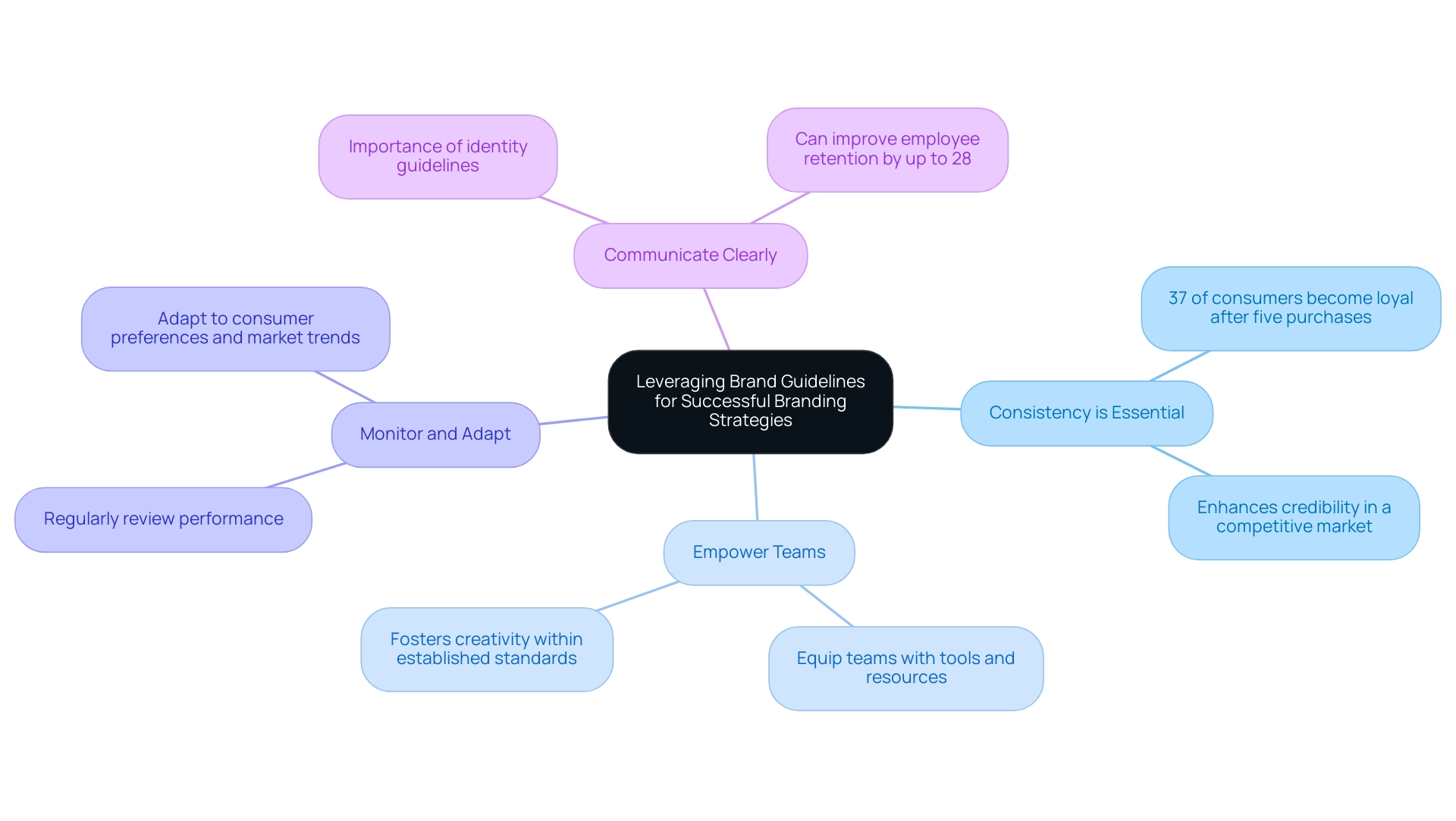
Conclusion
Establishing and adhering to robust brand guidelines is essential for businesses seeking to cultivate a strong and recognizable identity in today’s competitive marketplace. These guidelines provide a comprehensive framework that encompasses vital elements such as logo usage, color palettes, typography, and tone of voice. By maintaining consistency across all platforms, brands can foster consumer trust and loyalty, leading to enhanced brand recognition and ultimately driving business success.
The importance of aligning internal teams with brand values cannot be overstated, as it ensures that every member understands their role in upholding brand integrity. This alignment enhances collaboration and communication, contributing to a unified brand experience that resonates with both employees and customers. Moreover, adapting brand guidelines to meet changing market dynamics is crucial for remaining relevant and engaging with target audiences.
In conclusion, effective brand guidelines are not merely a set of rules; they represent a strategic imperative that can significantly impact a brand’s perception and performance. By investing in comprehensive and adaptable guidelines, businesses can navigate the complexities of branding, cultivate loyalty, and achieve long-term success. As demonstrated through various case studies, brands that prioritize consistency and clarity in their branding efforts are well-positioned to foster lasting relationships with their customers and thrive in an ever-evolving landscape.
Frequently Asked Questions
What are brand guidelines examples and why are they important?
Brand guidelines examples are essential frameworks that dictate how an identity is visually and verbally represented. They include components such as logo usage, color palettes, typography, and tone of voice. These guidelines help businesses maintain a consistent identity that resonates with their target audience, ultimately boosting recognition and fostering customer loyalty.
How does consistency in brand guidelines affect consumer trust?
Consistency in brand guidelines is crucial for uniform communications, which significantly contributes to building consumer trust. When companies use varying logos or color schemes, it can confuse customers and dilute brand identity. A consistent identity is perceived as more trustworthy, enhancing recognition and fostering loyalty among consumers.
Can you provide an example of a company that has successfully maintained consistency in its brand guidelines?
Quaker Oats is a prime example of a company that has successfully maintained a cohesive image through consistent brand guidelines. This consistency has helped bolster its strong market presence and build consumer trust.
What key components are typically included in brand guidelines?
Key components of brand guidelines typically include: Logo Usage: Instructions on logo variations, spacing, and placement. Color Palette: Defined primary and secondary colors that symbolize the brand. Typography: Specifications for font styles, sizes, and usage. Imagery: Guidelines for types of images that align with the brand identity. Tone of Voice: Instructions on how the organization communicates with its audience.
How do brand guidelines examples influence marketing strategies?
Brand guidelines examples help ensure that messaging is consistent and aligned with the organization’s identity. They empower marketing teams to make informed choices about communication strategies, ultimately enhancing storytelling and engagement with the target audience.
What are the benefits of implementing comprehensive identity standards?
Implementing comprehensive identity standards can lead to enhanced recognition and loyalty for organizations. Companies that adopt these standards often witness improved visibility and customer engagement, which are essential for sustained success in a competitive landscape.
Why is adaptability in brand guidelines becoming increasingly important?
As we approach 2025, trends in corporate standards are evolving to include more flexible and adaptive strategies. This adaptability is crucial for businesses to remain relevant in a rapidly changing market, as it reflects a company’s worth, market position, and customer loyalty—key drivers of revenue and competitive advantage.



